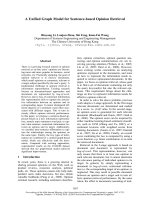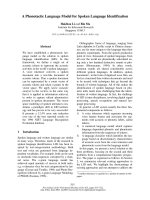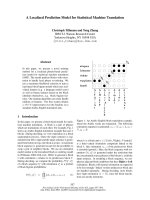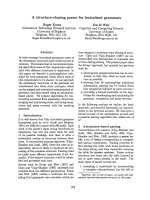Báo cáo khoa học: "A spoken dialogue interface for TV operations based on data collected by using WOZ method" pptx
Bạn đang xem bản rút gọn của tài liệu. Xem và tải ngay bản đầy đủ của tài liệu tại đây (55.23 KB, 4 trang )
A spoken dialogue interface for TV operations based on
data collected by using WOZ method
Jun
Goto
NHK STRL
Human Science
Tokyo 157-8510
Japan
goto.j-fw
@nhk.or.jp
Yeun-Bae
Kim
NHK STRL
Human Science
Tokyo 157-8510
Japan
kimu.y-go
@nhk.or.jp
Masaru
Miyazaki
NHK STRL
Human Science
Tokyo 157-8510
Japan
miyazaki.m-fk
@nhk.or.jp
Kazuteru
Komine
NHK STRL
Human Science
Tokyo 157-8510
Japan
komine.k-cy
@nhk.or.jp
Noriyoshi
Uratani
NHK STRL
Human Science
Tokyo 157-8510
Japan
uratani.n-fc
@nhk.or.jp
Abstract
The development of multi-channel digital
broadcasting has generated a demand not
only for new services but also for smart
and highly functional capabilities in all
broadcast-related devices. This is espe-
cially true of the television receivers on
the viewer's side. With the aim of achiev-
ing a friendly interface that anybody can
use with ease, we built a prototype inter-
face system that operates a television
through voice interactions using natural
language. At the current stage of our re-
search, we are using this system to inves-
tigate the usefulness and problem areas of
the spoken dialogue interface for televi-
sion operations.
1 Introduction
In Japan, the television reception environment has
become quite diverse in recent years. In addition to
analog broadcasts, BS (Broadcast Satellite) digital
television and data broadcasts have been operating
since 2000. At the same time, TV operations for
receiving such broadcasts are becoming increas-
ingly complex, and an ever increasing variety of
peripheral devices such as video tape recorders,
disk recorders, DVD players, and game consoles
are now being connected to televisions, and operat-
ing such devices with different kinds of interfaces
is becoming troublesome not only for the elderly
but for general users as well (Komine et al., 2000).
Recently we conducted a usability test targeting
data broadcasts in BS digital broadcasting. The
results of the test revealed that many subjects had
trouble accessing hierarchically arranged data.
This finding revealed the need for an easy
means of accessing desired programs. One such
means is a spoken natural language dialogue (here-
after spoken dialogue) interface for TV operations.
If spoken dialogue could be used to select and
search for programs, to operate peripheral devices,
and to give information in reply to system queries,
we can envisage such an interface as being ex-
tremely valuable in a multi-channel and multi-
service function viewing environment. With this in
mind, we have set out to build an interface system
that could operate a television via spoken dialogue
in place of manual operations.
2 Collecting dialogue data for TV opera-
tions
Assuming that a television is intelligent enough to
understand the words spoken by a human, what
kind of language expressions would a user use to
give commands to that television? In other words,
it is important that the words spoken by a user in
such a situation be carefully examined when de-
signing a television interface using spoken dia-
logues. Therefore first we built an experimental
environment that would enable us to collect dia-
logue data based on WOZ (Wizard of OZ) method.
2.1 Wizard of OZ
We set up a television-operation environment ac-
cording to the WOZ framework in which the sub-
jects were instructed that “the character appearing
on the television screen can understand anything
you say, and that the character will operate the
television for you.”
The number of channels that could be selected
was 19, and screens displaying Electronic Program
Guide (EPG) and user interface for program
searching were presented as needed (Komine et al.,
2002).
This WOZ environment required two operators,
one in charge of voice responses and the other of
user interface operations. The voice-response op-
erator returns a voice response to the subject by a
speech synthesizer after selecting a reply from
about 50 previously prepared statements or input-
ting replies directly from a keyboard. If the subject
happens to be silent, the operator returns a re-
sponse that introduces new services or prompts the
subject to say something. The user interface opera-
tor first determines what the subject wants, and
then manipulates user interface or EPG and per-
forms basic television operations such as changing
channels.
The subjects selected for data collection con-
sisted of 10 men and 10 women ranging in age
from 24 to 31 (average age: 28.7), and each was
allowed to speak freely with the television for 5
minutes under an assumption that the “television
has a certain amount of intelligence.”
2.2 Results of data analysis
Figure 1 shows an example of dialogue data re-
corded during a WOZ session. On analyzing col-
lected utterances made by the subjects (1,268
utterances in total), it was found that 83% of user
utterances concerned requests made to the televi-
sion, and that 89% of those requests included
words belonging to specific categories such as
program title, genre, performer, station, time, and
TV operation commands. The remaining 17% of
utterances did not concern the system but were
rather a result of subjects talking or muttering to
themselves for self-confirmation and the like.
Here, we consider the following reason why
most utterances belonged to specific categories
despite the fact that a variety of request could be
made. In this system, TV program- and operation-
related information is displayed on the television
screen, and based on this information, subjects
tended to underestimate television capability and to
omit utterances not dealing with service functions
they saw as possible. It is also thought that the
conventional image of television inside subjects’
minds served to restrict user utterances.
As a part of this WOZ experiment, we also had
the subjects fill out a questionnaire with regards to
television operations by using spoken dialogue
interface. When asked to give an opinion on oper-
ating a television by voice, more than half replied
“Yes, I would like to” therefore apparently indicat-
ing a high demand for the spoken dialogue inter-
face. On the other hand, most subjects that replied
“No, I would not like to” gave simple embarrass-
ment at speaking out loud as one reason and a re-
luctance to vocalize commands when watching
television together with their families as another.
In this regard, we think that embarrassment could
probably be reduced through user experience and
appropriate environment configuration.
3 Spoken dialogue interface system for
TV operations
Based on the results of the data analysis, we built a
prototype system that enables television operations
via spoken dialogue. Figure 2 shows the configura-
tion of this system. The system allows users to se-
lect real-time broadcast programs from 19 channels.
It also enables the presentation of program in-
00:27:08 Subject Well, I’m looking for a program.
00:30:23 WOZ You can also choose by genre.
Would you like to see the list of
programs by genre?
00:36:25 Subject Yes.
00:38:00 WOZ All right.
00:47:02 Subject Ah!
00:47:02 WOZ Please select a genre.
00:50:04 Subject Well, let’s see.
How about “Variety?”
00:55:11 WOZ OK!
01:02:06 Subject I see.
01:03:29 WOZ Please select the program you
would like to see.
01:08:27 Subject Well, I would like see more at the
bottom of the screen.
01:12:09 WOZ OK, I will do it.
01:15:23 Subject Um, Just a little bit more.
01:17:27 WOZ OK, how’s that?
Figure 1: Example of dialogue data
formation obtained from the Internet or overlaid
data in digital broadcasts; the scheduling of pro-
gram recording; and the browsing of program-
related information from Internet. All of these
functions can be operated through spoken natural
language interactions. The main processing mod-
ules of the system are described below.
3.1 Robot interface
The user makes operation requests to interface ro-
bot (IFR) as shown in Figure 3, and the IFR oper-
ates the television accordingly for the user. The
IFR is equipped with a super-unidirectional micro-
phone and a speaker, and communicates and acti-
vates the speech recognition and voice synthesis,
and dialogue processing of the system. The IFR
has been given the appearance of a stuffed animal.
One advantage of this IFR is that it can be directly
touched and manipulated to create a feeling of
warmth and closeness.
On hearing a greeting or being called by its
name, the IFR opens its eyes and enters a state that
can perform various operations. For example, the
IFR can assist the user search for a program, can
present information about any program on the tele-
vision screen, and can return voice responses.
3.2 Speech recognition
The speech recognition module uses an algorithm
that can finalize recognition results in a sequential
manner for a real-time operation and a high speech
recognition rate. When applying this module to a
news program, a speech recognition rate of about
95% can be obtained (Imai, 2000).
In speech that occurs during television opera-
tions, the words such as program titles, names of
broadcast stations, names of entertainers and etc.
have a high probability of occurring and are also
updated frequently. For this reason, newly acquired
word-lists are automatically registered in a diction-
ary on a daily basis. In addition, as program titles
often consist of multiple words, it is necessary to
register them as a single word in order to improve
the recognition rate.
Despite several additional forms of tuning, it is
still difficult to achieve perfect results with current
speech recognition technology. To enable feedback
to be given to the user at the time of erroneous rec-
ognition, results of recognition are always dis-
played on the lower left corner of the television
screen.
3.3 Dialogue processing
In dialogue processing, it is generally difficult to
understand intent by performing only a lexical
analysis of speech. If we limit tasks to dialogue
used in television operation, the words spoken by a
user have a high probability of falling into specific
categories such as program name, as indicated by
the results of the data analysis described in 2.2. As
a consequence, user intent can be inferred from a
combination of specific categories and predicates.
From the viewpoint of processing speed, process-
ing can be performed in real time if we use pattern-
base approach. This approach is also used in other
dialogue systems such as PC-based agent televi-
sion systems in the (FACTS) project and (Sumiyo-
shi et al., 2002).
The dialogue processing module performs real-
time morphological analysis of input statements
from the speech recognition module. A statement
is then identified by pattern matching in units of
morphemes and the meaning ascribed beforehand
to that statement is obtained. An example of such
pattern is shown in Figure 4 using the meta-
characters listed in Table 1:
User
Internet
Individual profile
management program
Program
retrieval
Profile
search
TV program
database
Dialog processing
Speech recognition
Voice synthesis
Machine
control
Presentation
Digital
broadcasting
Operation
request
Figure 3: Interface robot and an operation scene
Figure 2: Configuration of interface system
Table 1: Meta-characters used in pattern
In the pattern matching process, categories im-
portant to television operations are stored as slots.
Table 2 lists these category-slots and examples of
their members. The words stored in these slots are
then used as a basis for generating television op-
eration commands and search expressions to access
the TV program database. Response statements to
input statements may take various forms depending
on the patterns and current circumstances, and they
are here generated by taking into account slot in-
formation, response history, results of searching
for program information.
Table 2: Content of category-slots
4 Conclusion
We have built a spoken dialogue system based on
the results of a WOZ experiment with the aim of
achieving a television operation interface easy
enough for anybody to use.
In the preliminary system operation test, 5 sub-
jects were asked to give some examples of TV pro-
grams that they watch at home, and to use this
system to see whether they could obtain informa-
tion in relation to those programs. Results of this
test showed that all subjects could access informa-
tion on desired programs. In a subsequent ques-
tionnaire, moreover, all subjects stated that
“program selection was easy, and particularly there
was no need to know about hierarchical structure
of program information.”
On the other hand, the test also revealed that
some issues remain to be addressed in speech rec-
ognition but that a favorable evaluation could be
obtained from all subjects with regard to television
operations via spoken dialogue. We are currently
conducting even more detailed experiments to
demonstrate the usefulness of a spoken dialogue
interface for television control and to examine
problem areas.
References
FACTS (FIPA Agent Communication Technologies and
Services) A1 Work Package. Available at
/>.
Hideki Sumiyoshi, Ichiro Yamada, and Nobuyuki Yagi.
2002. Multimedia Education System for Interactive
Educational Services. Proceedings of IEEE Interna-
tional Conference on Multimedia and Expo, CD-
ROM.
Kazuteru Komine, Nobuyuki Hiruma, Tatsuya Ishihara,
Eiji Makino, Takao Tsuda, Takayuki Ito, and Haruo
Isono. 2000. Usability Evaluation of Remote Con-
trollers for Digital Television receivers. Proceedings
of SPIE, Human Vision and Electronic Imaging 5,
Vol. 3959:458-467.
Kazuteru Komine, Toshiya Morita, Jun Goto, and Nori-
yoshi Uratani. 2002. Analysis of Speech Utterances
in TV Program Selection Operations using a Spoken
Dialogue Interface. Proceeding of Human Interface
Symposium, No.3231:631-634. (in Japanese).
Toru Imai. 2000. Progressive 2-pass Decoder for real-
time Broadcast news captioning. Proceedings of
ICASSP-2000, Vol.3:1559-1562.
Meta
-
character
Description
*
any number of any words
+
o
ne wo
rd
!
n
o
n
-
ma
t
ching wo
rd
{}
o
ption
al
[]
m
andator
y
()
a
ny ord
er
@
s
lo
ts
|
or
,
d
elimit
er
Slot
Examples
@Moviename Blade Runner, My Fair Lady etc
@Performer’s
name
Harrison Ford, Chizuru Ikewaki
Norika Fujiwara, etc
@Genre Drama, Animation, News, etc
@Time 10:20, Tomorrow, Tonight, etc
@Broadcast
station name
NHK, TBS, WOWOW, etc
@Direct opera-
tion
Volume, Channel, etc
@Action Search, Watch, Turn up, etc
Input statement
I’d like to watch Blade Runner tonight
Pattern
* [watch|search] * @Moviename * @Time
Figure 4: Example of pattern matching









